Viloyat Akilova: An Uzbek Dance Legend, An Uzbek Dance Heritage
Part 1
By Robyn Friend
First published in Habibi, volume 19, number 3 and number 4
Viloyat Akilova is a member of a legendary Uzbek dance dynasty. Her grandmother Dovoro danced in the içkari (family quarters) for the Emir of Bukhara. Her father, Isakhar Akilov, born in Samarkand in 1914, was the founder of modern Uzbek dance choreography, and was one of the great masters of Uzbek dance in the 20th century. He was a National Artist of Uzbekistan, and a laureate of the Hamzi Government Prize; there is a street named for him in Tashkent, and there is a memorial plaque outside the home where he resided and taught for many years.
Viloyat’s mother, Margarita, was originally from Dushanbe, Tajikistan. In 1935, at age 14, she was brought to Samarkand to marry Isakhar. Thus began a 53-year collaboration that ended only with his death in 1988.
They came to Tashkent in 1937 with their young child, Viloyat, as a result of a talent search sponsored by the Uzbek government and conducted by Muhiddin Karayakubov, the first husband of Tamara Khanom[1]. In 1936, Isakhar Akilov, Muhiddin Karayakubov, Tamara Khanom, and Mukaram Turgunbayeva opened the Uzbek National Philharmonia Theater, where Isakhar organized many dance ensembles, including the Bahor Ensemble, the Shodlik Ensemble, Guzal Ensemble (for Kizlarkhon Dustmuhamedova), and many others. His choreographies appeared in many concerts and films, and he worked with many of the stars of 20th-century Uzbek dance.
Isakhar’s great contribution to the Uzbek dance tradition was to transform to the theatrical stage a dance form that was traditionally performed in intimate settings by soloists or small groups of dancers. Having large numbers of dancers perform together necessitated numerous changes in the traditional dance: dance movements had to be standardized, and dancers had to be taught technique in order to appear uniform. The Soviet approach to national dances started with the study of ballet technique; though surely something of the original flavor of the dance was lost, this approach led to better and stronger dancers, and more uniform styling.

Costuming also was transformed during this period. Costumes became more regularized, and the cut of the fabric more close-fitting and flattering to the figure. In addition, shoes had to be worn on the stage, whereas in the intimate indoor settings of teahouse and palace, shoes were not worn. Costumes that might be lovely up close would not be effective under stage lights, and so the addition of sequins and other forms of “glitz” was inevitable.
In 1987, retired dance master Roziya Karimova wrote a book about the work of Isakhar Akilov, titled Uzbek Dances in the Productions of Isakhar Akilov[2]. This book presents some of Isakhar’s best-loved works. It includes choreographies, music (composed especially for the dances), hand positions, stage directions, and even information about costuming.
Viloyat began dancing at an early age. By age 3, she was considered by some to be the star of the Akilov family show.
“I was born in Samarkand in 1937. My mother told me: “When you were in the womb you were already dancing”…When I was born it was very difficult, because my parents were always on tour. 1937 was a difficult year – we were hungry, there wasn’t much bread. No one had enough to eat.”
“I have never been a good housekeeper, I’ve never been a cook. My mother told me “Vika, you are an artist, you must save your hands for dancing.” So I never learned to do these things. When I was little my mother told me this all the time “Remember, you are an artist”. So I always danced. When I would go to bed my mother would show me hand movements.”
“One time I was on tour with my parents when I was only 9 months old. I was sleeping backstage with the costumes and set décor. When the concert was over, everyone went home, then realized Vika was missing! My parents wept, and rushed back to the theater. They opened a costume trunk and found me there sleeping!”
“When I was little and we had guests we would eat a lot and drink a lot. Then, my mother would say “Now Vika will dance”. I was only 3 years old! They loved it. I always knew that I was an artist.”
“Once when I was three I was being very fussy before a concert at a kolkhoz [collective farm]. I wouldn’t sleep, I wouldn’t eat. My mother said, “Vika is not dancing in the concert tonight because she won’t eat or sleep.” It was very primitive, no real stage, people sitting on the ground, no stage lights, only kerosene torches. When the concert was over my father went to collect the money from the head of the kolkhoz. He was told that he would not be receiving the entire amount of money because “the principal dancer of your company did not dance”. After that, I danced in every concert because my father was afraid he wouldn’t get all of his money.”

As a child, after studying piano some years, Viloyat applied herself (without the knowledge or assistance of her parents who were touring at the time) to enter the choreography school, where she studied for 9 years. Her father told her, “If you want to dance, you must finish college”. She went to the Nizami Pedagogical Institute, in the school of Russian Language and Literature, where she finished with top marks. Then she went to work at the Uzbek National Philharmonia, Ensemble Shodlik, where she danced as a soloist for 25 years. She had a huge repertoire of dances, encompassing all the styles of Uzbek dance. She says of herself, “Though I was heavy, I was strong and had excellent technique.” She was famous for her knee spins, and her elegant hands, as well as her flashing eyes and joyous expression.
Viloyat had never thought about becoming a teacher, but made the career change in 1976 when she reached age 40, the mandatory retirement age according to the Soviet system. Her father arranged for her to spend two years studying choreography with Igor Moiseyev in Moscow. When she returned home she began to organize the Zarafshan Bukharan Dance Ensemble. In 1987, she went to Afghanistan for one year to work in the Kabul Theater, organizing two ensembles: Nargiz and Shukufa. In 1989, she was awarded the title National Artist of Uzbekistan.
She has been the teacher of many of the greatest Uzbek dancers of the late 20th century, including Kizlarkhon Dustmukhamedova (National Artist of Uzbekistan), Firuza Salikhova (Honored Artist of Uzbekistan), Rushana Sultanova (National Artist of Uzbekistan), Roza Abdulkhairova (Honored Artist of Uzbekistan), and many others.

“My mother had five children. Tamara Khanom once said to her: “Margarita, why do you have so many children? Do you want to be a mat’ geroinya[3], or do you want to be a dancer?” My mother replied: “I want to be mat’ geroinya and a dancer!” My mother danced very well…. In 1977 [at age 56], she went to Budapest and danced Shodiyona, and took the gold prize”.
Viloyat’s sister Zuleikha (1945-2000) studied choreography at the Uzbek Choreographic School in Tashkent, and in Moscow. Zuleikha specialized in folkloric dances from all over the world, and in dramatic choreographies to modern music. Her sister Lola (born in 1957) also studied at the Uzbek Choreographic School in Tashkent, and later at the Institute of Culture. She is a lovely dancer in the traditional Uzbek styles, and also choreographs modern dances in a folkloric style; Lola now lives with her family in Israel. Lola’s (now ex-) husband, also a dancer, took the family name of Akilov, and still retains it. Viloyat’s sister Gawhar (born in 1949) studied music at the Music School in Samarkand, then came to Tashkent to study at the conservatory, and became a conductor. She specializes in the Mavrigi style of Bukharan dance[4]. Gawhar now lives with her family in Israel. The youngest child, their brother Yusuf (born 1963), a musician and composer, now lives in Moscow with their mother, who, at age 81, still dances every day.
The Akilov family dance dynasty continues, in the children of Viloyat’s sister Lola, and in the many dancers whose lives Viloyat has touched. Though Viloyat no longer specializes in knee spins, her beautiful hands and charming face endure
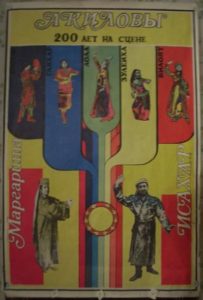
“I’ve worked a lot and I am happy. I have Robyn, Carolyn, Louchia, and Shoko.”
Part 2 of this article, to appear in the next issue, tells the tale of the author’s acquaintance with the great dance master, Viloyat Akilova, and her trip to Uzbekistan to study dance with her.
Viloyat Akilova: An Uzbek Dance Legend, An Uzbek Dance Heritage
Part 2
By Robyn Friend
Part 1 presented Viloyat Akilova, her dancing and teaching careers, and the heritage of dance in her illustrious family. Part 2 tells the tale of the author’s acquaintance with this great dance master, and her trip to Uzbekistan to study dance with her.
I first met Viloyat Akilova during her teaching tour to the U.S. in 1990. After struggling through a two-hour workshop with other teachers in my out-of-practice Russian and Uzbek, I was thrilled to find an Uzbek who spoke Tajik, which is mutually intelligible with Persian (which I speak much better than Russian or Uzbek!). We didn’t have much time to chat, but I remembered her when she returned to the U.S. in September 2001. At that time I was able to take some private dance lessons with her; she created for me a Khorezmi choreography, “Lyazgi”. We took to each other right away, and she kindly invited me to visit her in Tashkent, and study dance with her. I jumped at the opportunity, and arranged to fly to Tashkent in May 2002. Going to Central Asia to study dance is something of which I had been dreaming for more than 25 years; it just goes to show that hope and persistence really pay off in the end, if you don’t give up your dreams.
I had studied both Russian and Uzbek language more than 20 years ago, and began my preparations with cramming them both back into my head (I also speak Persian). Fortunately Viloyat also speaks some French, so we converse in an informal mélange of French, Russian, Persian, and Uzbek. I also spent a lot of time dancing and building my stamina, as I wanted to be sure I was fit enough to make the best use of my time, living 24/7 with my dance teacher. We also talked a lot on the phone before I left, and agreed on the three new dances she would teach me.
What shall I say of the 30-hour journey to Tashkent? On top of the previous 25 years or so it took me to get to this point, 30 hours was as nothing. And imagine what the journey from the New World to Central Asia would have been like just a century or two ago. I broke my journey in Istanbul, with a 7-hour layover at a nice hotel, courtesy of Turkish Airlines. A nap, a wash, and fresh clothes, and I felt ready to take on the world, including the 5-hour flight to Tashkent.
After passing through passport control and customs in Tashkent, I found Viloyat, surrounded by her family. Two carloads had come to make sure I arrived safely, and to transport my luggage and me to Viloyat’s apartment. We arrived at Viloyat’s apartment on a quiet, tree-lined street. On the outside of Viloyat’s building, where her parents had lived and taught, is a monument to Isakhar Akilov. Up the stairs to the second floor, and into Viloyat’s apartment, we entered the sitting room, a combination dining room and dance studio, the walls covered with photos from her illustrious dancing family. A bowl of soup, and I collapsed from exhaustion!
Viloyat let me rest the first day, but after that, to work! First, costumes: knowing I had only a short time in Tashkent, Viloyat had done lots of shopping and much careful planning. Five costumes in various stages of completion adorned my chamber in her apartment. It is possible to purchase or have made all the costumes and paraphernalia one might need, but the requisite items being not always available, it is best to make arrangements in advance. Viloyat had bought several items already, including the long sleeveless velvet coat embroidered with gold for the Khorezmi costume, and a similar shorter vest for the Ferghana dance. She had commissioned a pink chiffon dress to be partly made and embroidered with sequins, to be fitted when I arrived. She had purchased some gorgeous midnight blue velvet with gold and silver glittery paisleys on it, to be made into a long-sleeved coat for my Munajot costume. She had ordered all the flashy “stage gold” (that is, brass) jewelry for all five costumes, including necklaces, bracelets, earrings, crowns, belts, etc. Since each costume has its own complete set of jewelry, this amounted, when it finally arrived, to a huge mound of brassy, flashy, glittery, faux-jeweled finery, enough to set alarms bells ringing in every airport from Tashkent to Los Angeles!
For the Ferghana costume, she had selected a lovely dress made by a student of hers out of atlas[5]. The costume consisted of the dress, the velvet vest embroidered in gold, trousers to be made of atlas, and various and sundry bits of flashy jewelry. The last issue was the hat. We had originally agreed on a piece of music, and had bought a hat for the Ferghana costume. Subsequently, when we decided on a different piece of music, Viloyat insisted that a completely different hat was required, and an additional tilya qosh (crown) was necessary.
So, the first order of business was a visit to the Teatralniye Kombinat, the theatrical costume workshop where my costumes would be completed. The journey there was short in time, but covered an interesting variety of sights, starting with wide avenues lined with trees, parks, and public buildings. Then, a sudden left turn took us into some twisting, narrow little alleys, and there we were, at the Kombinat. There, Mashkura-opa[6] with quick and agile fingers took my measurements, sketched the costume pieces still to be made from scratch, and fitted those already started. Following this, a lunch of somsa, a lamb and onion pie, and plov, saffron rice with garbanzos, onions, grapes, lamp chunks, with green onions and fresh cilantro on top. The cilantro, plus the green tea served in little bowls reminded me that I was now closer to China than to the Mediterranean.
Back at Vika’s apartment, we started my first new dance, Munajot. This dance is an old, classical Uzbek dance, with many variations. According to Viloyat, the music for Munajot is played at every wedding, and is loved and danced improvisationally by everyone: men, women, and children (evidence for this was born out at the wedding I attended later on in my trip). The origin of the dance is in the classical poetry of Ali Sher Navoi, the beloved classical Uzbek poet [1441-1501]. The word “munajot” means “an appeal to God”. The poem depicts a young woman arriving for an assignation with her sweetheart, a metaphor for our relationship with God the Beloved. She waits, but he does not appear. Suddenly, a change of music indicates that she sees him, and she is delighted and happy. But the music changes again, and she realizes it was just an illusion.
We had been working on this challenging dance for about one hour when Viloyat received a phone call: her presence in Bukhara was requested by the president of Uzbekistan, where she was to serve on the jury of a dance competition. Suddenly, we were making preparations to leave in two days for the legendary city of Bukhara!
Our journey began at Uzbek Raks, the administrative and rehearsal center for all the major Uzbek dance groups of Tashkent, and the home of the Museum of Mukaram Turgunbayeva, one of the early founders of 20th-century Uzbek choreography. Our journey took us through a huge, wide valley, very reminiscent of California’s Central Valley’s seemingly endless miles of fruit orchards and other food crops, except for the women wearing dresses and trousers of atlas, and the high, snow-capped peaks in the distance.
The journey took 9 hours, during which time we made one stop at a chaikhana (traditional teahouse), where Viloyat and I refreshed ourselves with green tea and pelmeni, a thin pasta filled with lamb and onion that closely resembled Chinese dumplings.
We knew we had entered Bukhara when we spotted a huge brick gateway covered in gorgeous turquoise tiles with a peacock motif. There are many such old tiled buildings in Bukhara. The Emir’s summer palace is a pleasant spot during the heat of the day, set amidst gardens and fountains. In the entrance courtyard are vendors selling all kinds of Bukharan-style gold embroidered coats, shoes, and hats, tea cozies, fans (much needed in the heat of the day), atlas scarves and sunglass cases to hang around your neck, and cotton embroidered hats and shoulder bags. We paid a quick visit to the Ark Fortress, the home of Bukharan rulers first built in the 7th century, and remodeled, reinforced, and rebuilt over the centuries.
The day of the competition I watched the rehearsal of the show, which included, in addition to the girls competing solo, performances by some of the best-known ensembles of Uzbekistan: the Uzbekistan Ensemble, Ensemble Lyazgi (which specializes in Khorezmi-style dance, from Khiva), Tanavar Ensemble, and the Bahor Ensemble. It was wonderful to see so much dancing, and such a variety of styles, all at once. By the time all the events in Bukhara were over, I had gotten to see each dance three times.
One thing that truly amazed me was to see the poor condition of the stage. It was made of 4-inch wide unpolished wood planks, with gaps where the planks joined. I assumed at first that they would be putting down a floor covering over the stage so that the dancers could have a smooth surface to dance on, but no….all the spins and rapid footwork were performed on a stage that no American dancer would willingly set foot to. And this was by no means the worst surface upon which I saw dancers performing: uneven tiles, uneven concrete, half carpet and half linoleum over a bumpy uneven wood floor, I saw Uzbeks dancing on everything. I became even more impressed at the skill of these dancers, to perform so brilliantly when handicapped by such difficult circumstances.
That night was the competition itself, honoring Mukaram Turgunbaeva, who was the first to choreograph the classical Uzbek dance, Tanavar. I decided to test myself and see if I had learned enough about Uzbek dance styling and execution to judge the dancers appropriately: I found that my scores were the same as Viloyat’s every time!
The judges (and I) had been invited to the home of a local musician for dinner. After the competition, we were taken on a tour of Bukhara’s narrow dusty alleys to the home of musician Nishonjon Atamuradov and his wife. We entered through a gate in a high wall into a pleasant courtyard with fruit trees and other flowering and fruiting plants. After greeting our hosts we were invited to sit around a table loaded with food. Thus began a meal that was characteristic of all other formal meals I enjoyed in Uzbekistan. Platters of salami and cheese, huge bowls of fresh fruit, the ubiquitous Uzbek nan (flat bread), and smaller bowls of pickled cabbage and carrots started the meal. Then course after course of lamb and carrot soup, shashlik, and other dishes followed. In between the courses, each guest was invited to make a toast or speech, washed down with copious quantities of wine, vodka, or cognac. I couldn’t keep up, with the speeches or the drinking, but settled down to enjoy watching the others enjoy themselves.
Nishonjon was prevailed upon to bring out his doire (frame drum) and sing. He sang songs in Uzbek, and in Mavrigi Persian, and invited us all to dance. I was a bit shy at first, but after prompting from Viloyat, I did dance. The best part for me was getting to dance with Gawhara, the director of the Lyazgi Ensemble. Her daughter, Alicia, had come in second in the competition with two stunning dances in the Khorezmi style, a style of dance and music I really love. Dancing with Gawhara, I picked up some more Khorezmi steps and styling to add to my repertoire. I also danced with Yulduz Ismatova, the director of the Tanavar Ensemble, of Uzbek Raks, and of the competition. I think at first she was annoyed at having this American nobody hanging around her competition. But dance is a universal language that can break down many barriers, and her resentment soon melted away. After ascertaining that everyone one had had enough to eat and drink, the meal ended with a prayer, and we returned to the hotel.
The next day the mother of the dancer who had taken first place in the competition took us to lunch, at a restaurant inside a turquoise-tiled building, facing another such building across a square. As before, we began and ended with a prayer, and in between, copious quantities of food and drink, until I thought I’d die from overeating! I was prevailed upon to make a speech, so did my best, impromptu, in French with Viloyat translating, and a few phrases in Russian and Uzbek.
The next night was a dance concert, and the presentation of prizes to all the competitors. The group dances were all repeated, and the soloists performed in reverse order of placement. The final solo dance was by the winner of the first prize, who did a gorgeous dance in a peacock costume.
The judges and I had again been invited to dinner afterwards, this time with the Mayor of Bukhara.We were taken to a beautiful restaurant, with a large square pond with fountains, surrounded by turquoise-tiled Bukharan-style buildings. It was into one of these buildings we went for our dinner. By now, I knew what to expect, and paced myself accordingly, except that this meal included two more courses than I was prepared for. Yulduz Ismatova surprised me by presenting me with a gift, acknowledging the interest of an American in Uzbek dance. This came as a surprise to the Mayor, who stated that he had believed me to be Uzbek! It seems it is after all possible to blend in.
After a hot 12-hour ride in a train compartment without air-conditioning or ventilation, we returned to a cool and rainy Tashkent. The first order of business was breakfast, then a quick trip to the Kombinat to check on my costumes. The Kombinat, an aging building in the stark early Soviet style, was nonetheless a feast for the eyes of a costume fanatic. Fabrics and costumes in various stages of completion draped everywhere, swatches of trim, strings of beads and sequins, patterns hanging here and there. Mashkura-opa did some more fitting, and handed me a pile of finished costume pieces, perfectly fitted and finished, complete with jewelry and accessories. Oh Joy! Dance costumes I didn’t have to make myself!
Once back in Tashkent, Viloyat and I were invited to several social engagements, including a wedding, a birthday party, and a celebration of the 40th day after a birth.
The wedding was held outdoors in a wealthy suburb outside of Tashkent. At first I thought the location was a venue specifically for weddings, such as we have here in the States. It was all so well organized: long banquet tables enough to seat at least 200 people, each table loaded with the by-now familiar first dishes, plus a few others new to me. Later I learned that this was actually the cul-de-sac in front of the home of the groom and his grandmother, where he and his bride would live. Meanwhile, the bride and groom, she in a white dress and white veil covering her face, he in a dark blue Uzbek man’s coat with gold embroidery, were being lead to the party by a band of four karnais[7], a sornai[8], and two doires[9] playing traditional wedding tunes. Once the group arrived at the party and the bride and groom were seated, the band continued to play, the karnai players blatting out their rhythmic single notes while executing various choreographic formations on the dance floor.
Then a pop band (electric guitar, keyboard, and drum set) began to play, accompanying several different singers. The guests jumped up and began to dance. At one point the band played the music for Munajot, and Viloyat danced it for us. At several points throughout the evening, men from one table or another would get up, file onto the dance floor with money in their hands, and present the money to the musicians. Money was also given by onlookers, and apparently by members of the wedding party who had great wads of it in their hands[10], to the dancers, who then passed the money on to the band.
I had noticed before (in our hotel in Bukhara, for example) that though there is no enforced separation of men and women (as, for example, in Sa’udi Arabia), men and women sit at separate tables during social functions. Our table was no exception, though the husband of Viloyat’s friend, Adolat-opa, joined us briefly at the first, then left to sit with some other men. We said our own prayer at our table, then dug in as course after course of food appeared, to be eaten in between the speeches and toasts.
In between each course we danced. The social dancing is similar to Uzbek classical dance; it also resembles Persian social dance in form and style, but there was no reluctance to dance, as there is among Iranians. Everyone clearly took delight in dancing and in watching each other dance.
After we had danced a bit, and eaten what I had thought was our fill, I was invited to see the interior of the house. We walked through a gate underneath part of the house, into a large smoke-filled courtyard where the food was being prepared. Up a few steps and into the house where there were several neat and tidy rooms, one with an elegantly laid table and chairs, others with a low table and thick quilts to sit on. At the back of one wall was a tall pile of hand-made quilts, some of velvet, some of atlas, half made by the bride and her family, half made by the groom’s family. It reminded me of the interior of Qashqa’i[11] tents, where all the bedding and clothing are stacked at the back of the tent during the day, with their colorful coverings exposed, or covered with kilims. It brought to mind the common roots of these two peoples, and the distant nomadic past of the Uzbeks.
Upstairs we could see the wedding going on below, and hear the band well enough to dance some more. I had thought we had done eating, but no. In came plates of steaming hot beef shashlik and another platter of liver shashlik. Finally, we judged it was time to head back home. We were each presented with a bag of nan, sweets, and atlas to take with us, a favor traditionally given to every guest at a wedding.
A few days later we were invited to attend a traditional birth celebration, celebrated on the 40th day after the birth. The daughter-in-law of Melika-opa, a friend of Adolat-opa and Viloyat, had just given birth to her third child. The party was at Melika’s home in the suburbs of Tashkent. As we entered the marble courtyard we could hear the strains of a traditional Uzbek band of tar, dotar[12], violin, and doire, with vocal duets by the musicians backed up by the tinkling of fountains. We were led inside and seated at tables groaning with dishes of food, where we were entertained by the musicians as we ate.
There was also a pop band, and these two groups of musicians took turns entertaining us. Of course, we all got up and danced with and for each other. At one point Viloyat and I danced together. Viloyat, who sometimes has difficulty walking, becomes another creature while dancing. I soon sat down and just shared the pleasure of watching her come alive to the music.
It wasn’t all fun and parties, though; I still had three dances to learn and get ready to perform in a concert before I left!
Viloyat’s teaching style is very much influenced by the Soviet system and her work with Igor Moiseyev, as well as her stern Papa. Though she is very sweet by nature, she becomes a grim taskmaster when teaching: no excuses, frequent criticism, none of the self-esteem building we in America use for teaching. Afterwards, she smiles and tells me I have done very well indeed. “Please don’t be angry with me because I yell at you,” she says. “It’s just a teaching technique, and it works. You never forget what I tell you, and you learn faster.”
Though it is a bit uncomfortable during the lesson, I have to agree. After all, I learned three choreographies in a very short time, even given our distractions in Tashkent and the trip to Bukhara, in a dance style with which I formerly had only a passing familiarity.
In addition to Munajot, Viloyat honored me by teaching me her mother’s signature dance, Shodiyona, which her mother had only ever taught to Viloyat, and had never allowed her to teach to anyone before. I have been given this dance with the instruction that I may dance it as long as I wish, but may teach it to someone else only after I have retired from performing it. It is an exciting dance in the Bukharan style, accompanied by three doires plus the rhythmic honking of the karnai. It features the characteristic Bukharan wrist shivers with bells, dainty Bukharan footwork, and wonderful percussive movements of shoulders, hands, and head.
The third dance I learned is in the Ferghana style, to a popular traditional wedding tune, called Otmagay Tong, on the sornai and orchestra. This dance depicts a bride awakening on her wedding day, not sure if she is happy or sad, as she prepares herself for her big day. It includes a section of miming makeup and combing and braiding the hair, movements familiar to me from raqs-e bazak, the Persian makeup dance.
Finally the day of the concert arrived; it went very well. I was given many nice compliments, and Viloyat told me she was pleased with all her students. I danced the four dances I had learned from Viloyat, and shared the stage with three other of Viloyat’s students, two Uzbek girls, and Shoko, a Japanese woman living in Tashkent to study Uzbek language. Because of Shoko, the audience members included a delegation from the Japanese embassy.
Shoko told me that she had wanted to learn some Uzbek social dance, because everyone in Tashkent danced, but in Japanese society dance is only for professional artists. “I only wanted to learn to dance at parties,” she said. “I never dreamed I would put on makeup, something I have never done before in my life, and put on a costume and perform for other people.” Such is Viloyat’s charisma, teaching abilities, and charming persuasion, that she can talk anyone into dancing!
The day before I was to leave Tashkent was a whirlwind of shopping and sightseeing. First was a trip to the Chorsu, the bazaar in central Tashkent. Here you can buy tea sets, cheap plastic toys made in China, fresh crisp nan still steaming hot, face cream, audio cassettes, gold embroidered traditional Uzbek garments and shoes, and atlas. I bought as much as I thought I could fit in my bags, and left the rest for another time.
That night Karina and Zumrad, neighbors of Viloyat, took me on a sightseeing tour of downtown Tashkent. It was my first chance to see Tashkent on foot, and my first opportunity to sight-see with someone who spoke English.
First we went to the Navoi Theater, where Karina had worked for years as the choral director. A lovely building, the interior is decorated with the famous Uzbek intricate plaster work, each room in the style of a different part of Uzbekistan. On stage was a competition of Latin ballroom dancing. We got to see the 7- to 10-year-olds doing the waltz, quick step, rumba, mambo, and jitterbug.
Then we went to the “Montmartre of Tashkent”, a walk-street where vendors sell works of art, caricatures, handicrafts, and antiques, and eatables like tea and ice cream. Across the street is Amir Timur Park, which has had many incarnations since it was first built. The first statue to grace this now leafy-green park with its allées of trees was general Konstantin Kaufmann in 1882. The Bolsheviks replaced Kaufmann’s statue with busts of Lenin, and renamed the park Revolution Garden. In 1947, Stalin replaced Lenin, and in 1968, Stalin was in turn replaced by Karl Marx. Finally, in 1993, as a mark of Uzbekistan’s newly-won independence, Marx was replaced by Amir Timur, Tamerlane as he is known in the West.
The next day I said my final farewells to my friends. My flight left at the ungodly hour of 3:30 a.m. Viloyat and her daughter took me to the airport. I had been somewhat worried about the exit procedures, and especially about being overweight in my baggage and needing to carry on board with me two heavy bags with all my new costumes in them. I needn’t have worried. Viloyat flashed her National Artist of Uzbekistan identification, and doors magically opened for me.
One thing I really loved about dancing in Uzbekistan is that, unlike elsewhere in the Near East, dance is an honored profession. The best teachers and dancers are awarded titles by the government of Honored Artist and National Artist. You don’t have to be young or fashionably thin to be considered a good dancer; you are judged by your dance abilities alone: technique, musicality, and expression.
I will definitely return to Uzbekistan. There is so much to see, and so much more to learn. In the meantime, I’ve got lots of practicing to do.
